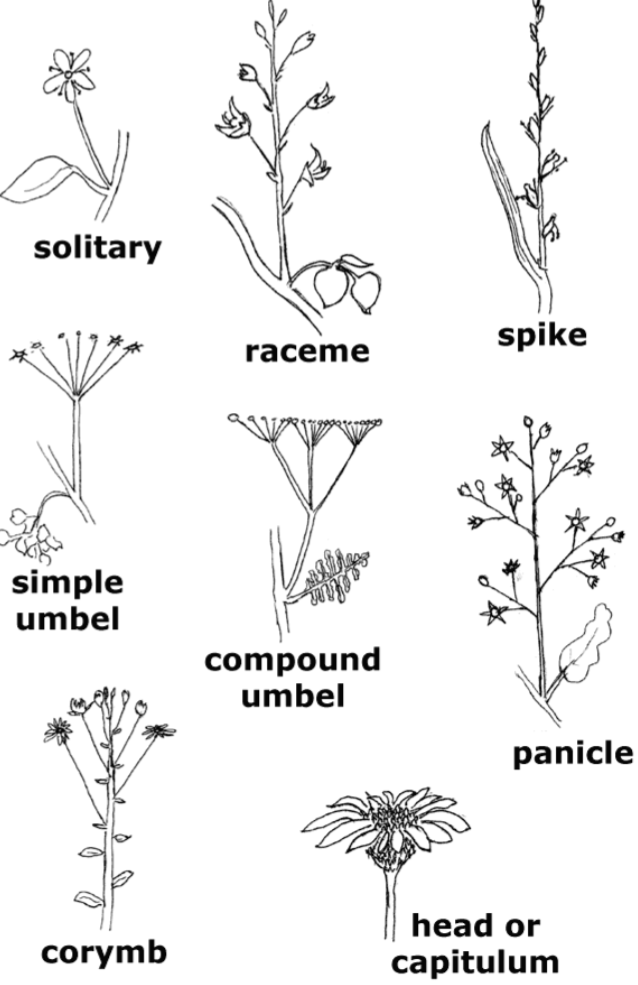BIOL 1030 Hawthorne Exam 2
1/71
There's no tags or description
Looks like no tags are added yet.
Name | Mastery | Learn | Test | Matching | Spaced |
|---|
No study sessions yet.
72 Terms
What are plants evolved from?
Charophyta, a green algae
What are characteristics of plants?
multicellular, photoautotrophic, heteromorphic sporic meiosis, terrestrial or secondarily aquatic, cell walls made of cellulose, movement by growth only, and the embryo is protected by gametophyte tissue (embryophyta)
What are the 4 major plant groups?
nonvascular, seedless vascular, gymnopsperms, and angiosperms
What are nonvascular plants also known as?
bryophyta
Nonvascular plant characteristics
3 extant phyla, gametophyte dominant, water is required for sperm dispersal, usually in moist habitats, and small plants
What are the 3 nonvascular plant phyla?
hepatophyta (liverworts), bryophyta (true mosses), and anthocerophyta (hornworts)
What are the characteristics of Anthocerophyta?
simple, charophyte- like thalus, horn-like sporophyte, dehiscent (bursts open), and photosynthetic sporophyte
What are characteristics of Hepatophyta?
dichotomously branching thallus, gemma cup, umbrella shaped antheridiophore (male), palm tree shaped archegoniophore (female), has a foot for absorbing nutrients, a capsule/ sporangium that makes spores via meiosis, and has elaters on spores which anchor them to the ground
Bryophyta (true moss) characteristics
haploid meiospore, grows into protonema with leafy shoots and rhizoids, splash cup, meiosis in capsule, calyptra/ operculum prevents spores from drying out, peristome, hygroscopic dispersal
What is the peristome
ring of interlocking tooth-like structures
What is hygroscopic dispersal
“teeth” open in dry conditions and close when moist, facilitates gradual dispersion over long distances
What is the significance of vascular tissue?
Allows for larger/taller plants in dryer habitats, better access to light for photosynthesis
Seedless vascular plants characteristics
Sporophyte dominant, gametophytes variable, often hidden (can be photosynthetic or not, above or below ground, attached or unattached, etc)
Xylem
conducts water and minerals, dead, lignefied cells, provides stem strength for height
Phloem
distributes sugars, amino acids, and organic products, is alive
dermal tissue system
outer covering layer, like skin
ground tissue system
fills space between DTS and VTS
Microphyll
small, unbranched vascular
apical meristems
root and shoot, primary growth, increase in height
lateral meristems
Secondary height, increase in girth
heterospory
microspores (male) and megaspores (female), all seeded plants and some seedless vascular plants
Monilophyta
Seedless vascular plant super phylum, pteridophyta, equisetophyta, psilophyta
Psilophyta
Whisk ferns, lack true leaves and roots, dichotomously branching stems, sporangia born on stem (homospora
Equisetophyta
horsetails, living fossil, one extant genus, pot scrubbers, hollow ribbed stem, toughened with silica and whorls of microphylls at nodes, strobili with sporangiophores, homosporus, elaters function in spore dispersal (hydroscopic)
Pteridophyta
Ferns, usually pinntely compound- rachis( center stalk) and pinnae (single leaflets), circinate vernation (frond fiddlehead to developed frond), rhizome and aventitious roots grow outside the soil
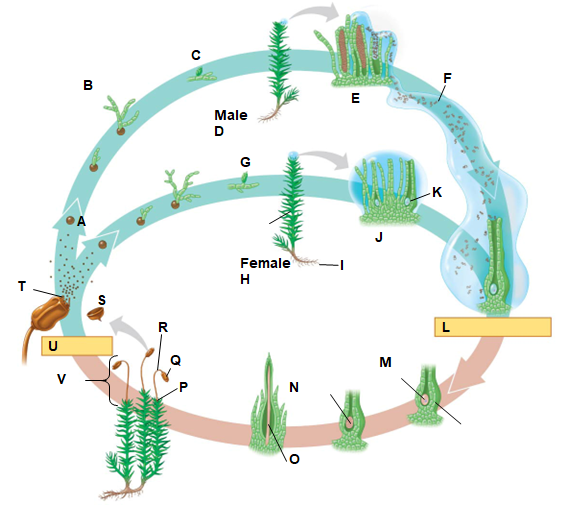
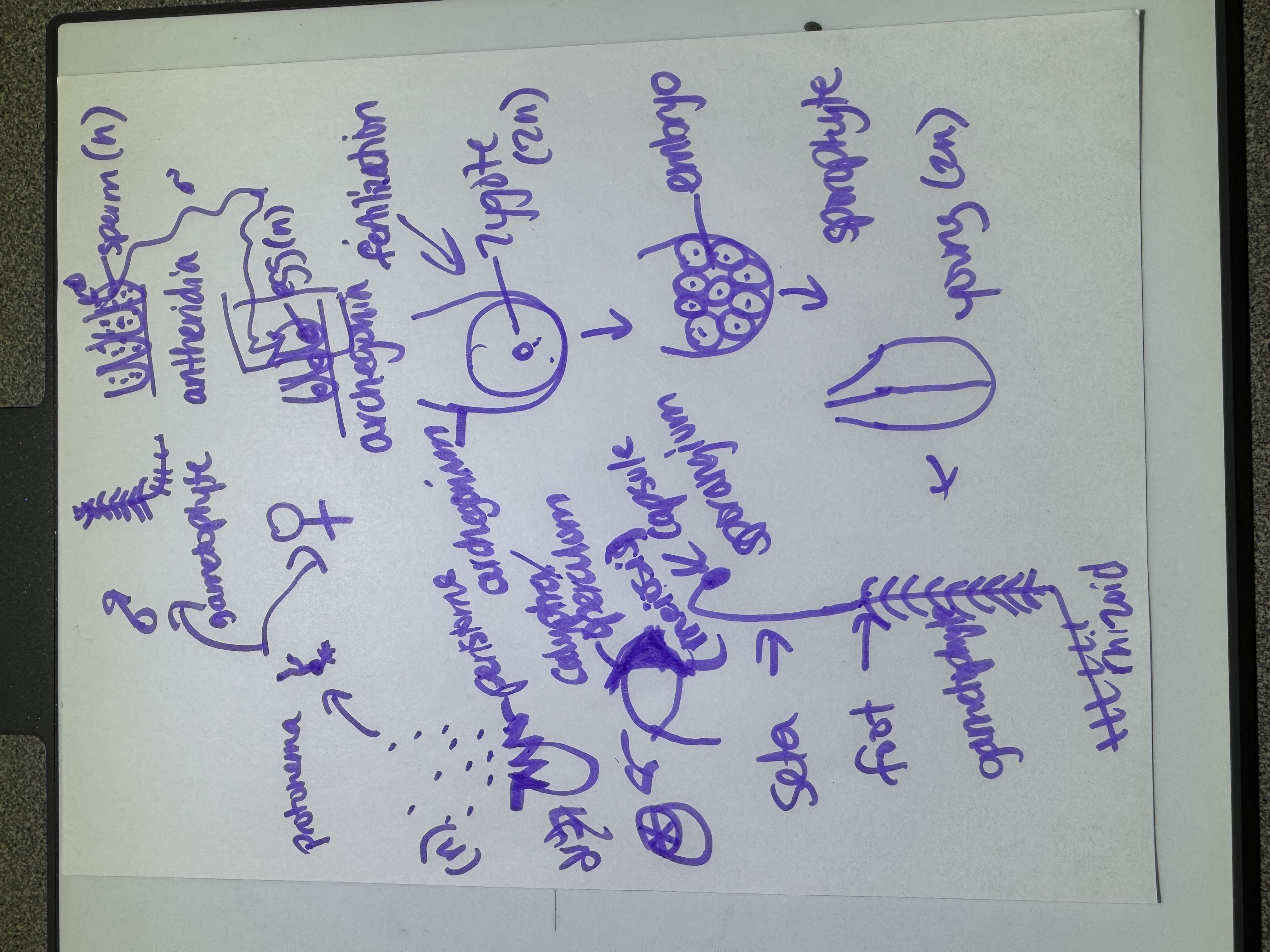
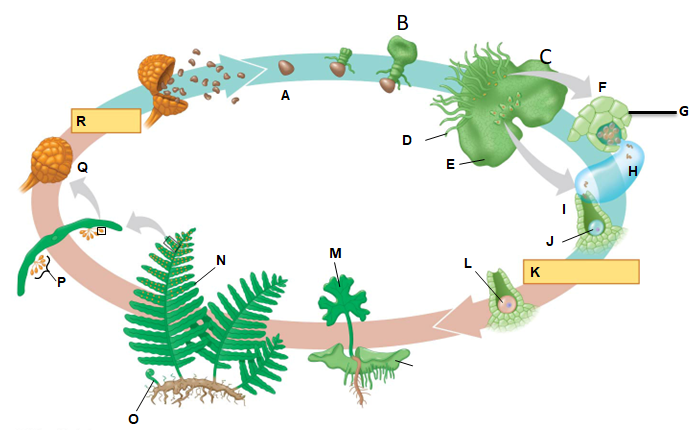
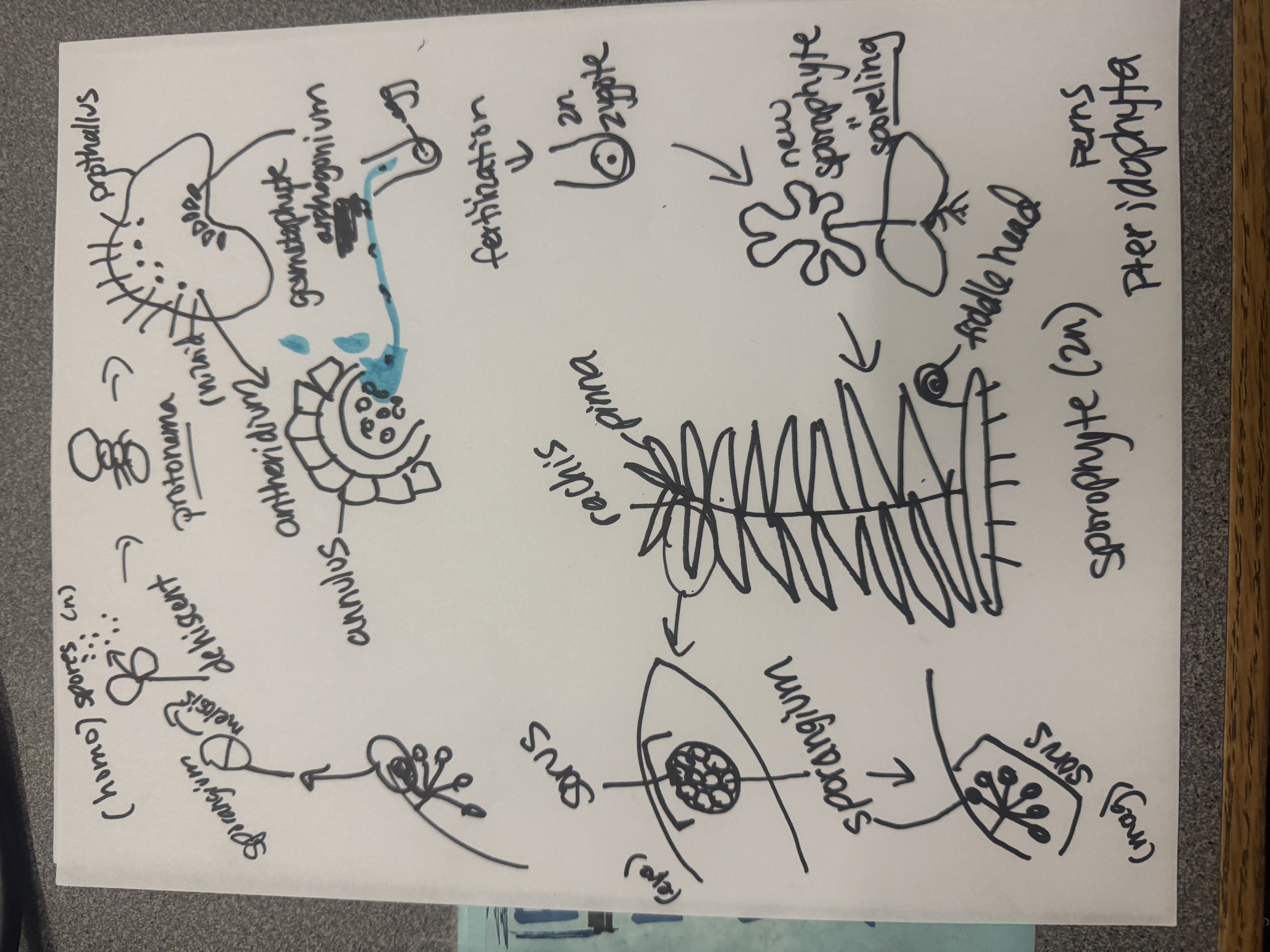
Lycophyta
club mosses, ground pine, ressurection plant, quillwort, microphylls, strobilus
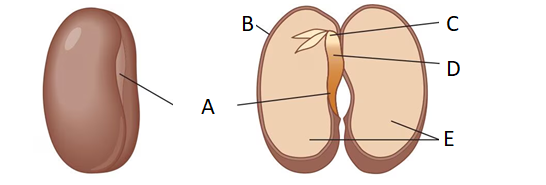
B-seed coat, E- cotelydons, A- Radicle, C- Epicotyl, D- hypocotyl
Characteristics of gymnosperms
4 extant phyla, vascular tissue, dominant sporophyte generation, larger plants,heterospory
Gymnosperm phyla
Gnetophyta, ginkgophyta, cycadophyta, coniferophyta
Gnetophyta
Dioecious (male and female plants), 3 extant genera- gnetum, welwitskhia, and ephedra
ginkgophyta
monotypic, deciduous, dichotomous venation (forked y pattern), bilobed leaves, dwarf branches have leaves, dioecious, smelly, fleshy seed coat
Cycodophyta
cycads (short and palm like), dioecious, microsporangiate strobilus, megasporangius strobilus, herbiverous beetles feed on pollen cones
Coniferaphyta
pines, fir, spruce, hemlock, redwood, sequioia, juniper, cedar, etc (large evergreens)
Coniferophyta life cycle
monoecious (male and female on one plant)


integument
protection, becomes seed coat
micropyle
small opening for pollen grain
angiosperms
basal angiosperms (magnolias, etc, paraphyletic), monocots, eudicots
Angiosperms phylum
magnoliophyta
Whorls of a flower
Calyx (sepals), corolla (petals), calyx and corolla (perianth), androcium (stamens), gynocium (carpals)
Perfect flower
has male and female parts
complete flower
has all four whorls
Incomplete flower
lost a whorl
monaceous
male and female whorls on one plant
dioecious
male and female on separate plants
connation
fusion within a whorl
adnation
fusion between whorls
inflorescence
an arrangement of flowers on a branch/stem
Monocots
one cotyledon, parallel veins in leaf, scattered vascular tissue, no main root, pollen grain with one opening, floral organs in multiples of 3
Eudicots
2 cotyledons, veins netlike, ring of vascular tissue, taproot, 3 openings in pollen grain, floral organs in multiples of 4 or 5



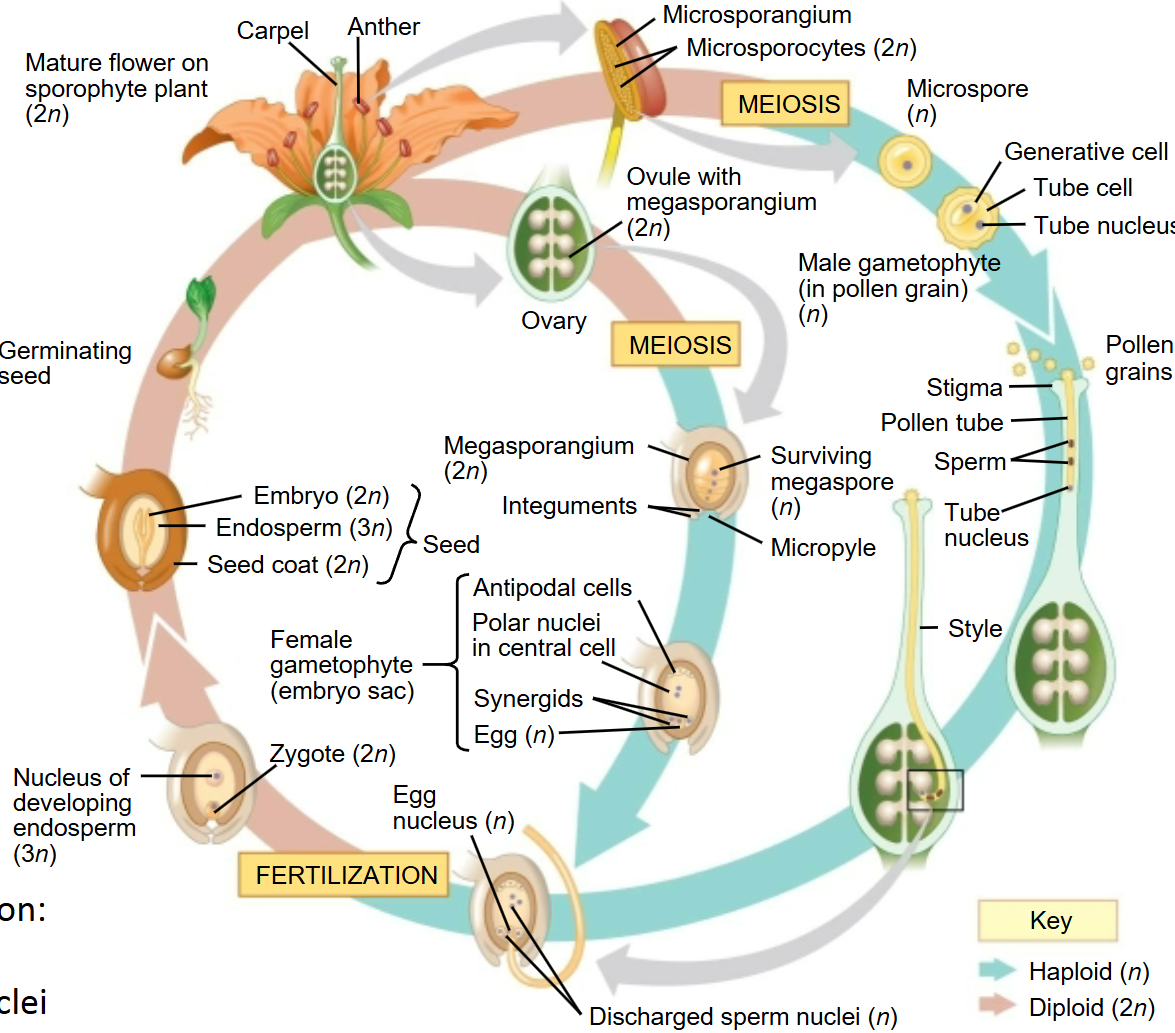
What is a fruit
container for seeds, develops from ovary wall, can be dry or fleshy
Accessory fruit
developed from more than just the ovary
multiple fruit
multiple flowers, one fruit
aggregate fruit
each achene is a separate carpal from a single flower
berry
all or most of pericarp is fleshy
pepo
a berry with a hard, thick rind
hesperidium
a berry with a leathery rind
drupe
fleshy with a stony endocarp
pome
ovary surrounded by fleshy hypanthium
Dehiscent
many seeded
legume
2 sutures
capsule
more than one carpal and more than two sutures
follicle
one carpal and one suture
samara
winged
nut
hard shell
achene
attaches at a single point
caryopsis
endocarp fused to seed (grain)

